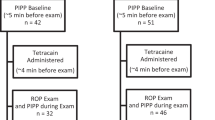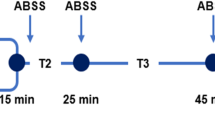Abstract
Background
Music for neonatal pain has not been exclusively studied in term neonates in a well-designed trial compared to the standard of care. This study aims to assess the effectiveness of music intervention as an adjuvant in relieving acute pain in term newborns undergoing minor painful procedures.
Methods
This randomized, controlled, blinded trial included any term neonate undergoing heel prick. Both control and intervention groups received oral sucrose 2 min before heel prick. Intervention group was exposed to ‘Bedtime Mozart’ lullaby recorded music via bedside speakers. Pain was measured using Neonatal Infant Pain Scale (NIPS) at 1-min intervals. Investigators were blinded using noise-canceling headphones that played random music.
Results
A total of 100 neonates were enrolled. Mean gestational age was 39.2 weeks, and mean duration of the procedure was 113 s. Music group was found to have significantly lower pain scores [OR = 0.42 (0.31, 0.56), p < 0.001]. Baseline NIPS scores were similar across groups and there was no interaction effect between groups and time. When NIPS were categorized as pain and no pain, there continued to be statistically significant lower NIPS scores in the music group (p < 0.001).
Conclusion
Recorded music, in addition to sucrose, is efficacious in reducing pain, encouraging its use in term neonates.
Impact
-
Recorded music effectively reduces pain induced by minor procedures in term neonates.
-
Clinical studies have shown that live and recorded music induces changes in vital signs and pain scores in the NICU’s predominantly preterm population.
-
Most of these studies were also conducted in the white ethnic population.
-
Our study objectively proves reduction in pain scores by using recorded music in a randomized, controlled, blinded study of predominantly non-white, term neonates.
-
Recorded music is effective in reducing acute pain in term neonates and can be widely used even in low-resource nurseries.
This is a preview of subscription content, access via your institution
Access options
Subscribe to this journal
Receive 14 print issues and online access
$259.00 per year
only $18.50 per issue
Buy this article
- Purchase on Springer Link
- Instant access to full article PDF
Prices may be subject to local taxes which are calculated during checkout


Similar content being viewed by others
Data availability
The datasets generated during and/or analyzed during the current study are available from the corresponding author on reasonable request.
Change history
29 September 2023
A Correction to this paper has been published: https://doi.org/10.1038/s41390-023-02834-5
References
Perry, M. et al. Neonatal pain. Crit. Care Nurs. Clin. North Am. 30, 549–561 (2018).
Tobias, J. K. & Deshpande, J. K. Pediatric Pain Management for Primary Care (American Academy of Pediatrics, 2005).
Olsson, E. et al. The use and reporting of Neonatal Pain Scales: a systematic review of randomized trials. Pain 162, 353–360 (2021).
Stevens, B., Yamada, J., Ohlsson, A., Haliburton, S. & Shorkey, A. Sucrose for analgesia in newborn infants undergoing painful procedures. Cochrane Database Syst. Rev. 7, CD001069 (2016).
Wade, C. et al. Development of locally relevant clinical guidelines for procedure-related neonatal analgesic practice in Kenya: a systematic review and meta-analysis. Lancet Child Adolesc. Health 4, 750–760 (2020).
Benoit, B., Martin-Misener, R., Latimer, M. & Campbell-Yeo, M. Breast-feeding analgesia in infants: an update on the current state of evidence. J. Perinat. Neonatal Nurs. 31, 145–159 (2017).
Johnston, C. et al. Skin-to-skin care for procedural pain in neonates. Cochrane Database Syst. Rev. 2, CD008435 (2017).
Ranger, M., Albert, A., MacLean, K. & Holsti, L. Cerebral hemodynamic response to a therapeutic bed for procedural pain management in preterm infants in the NICU: a randomized controlled trial. Pain. Rep. 6, e890 (2021).
Johnston, C. C., Filion, F. & Nuyt, A. M. Recorded maternal voice for preterm neonates undergoing heel lance. Adv. Neonatal Care 7, 258–266 (2007).
Rossi, A. et al. Music reduces pain perception in healthy newborns: a comparison between different music tracks and recoded heartbeat. Early Hum. Dev. 124, 7–10 (2018).
Standley, J. Music therapy research in the NICU: an updated meta-analysis. Neonatal Netw. 31, 311–316 (2012).
Ghetti, C. et al. Longitudinal Study of music Therapy’s Effectiveness for Premature infants and their caregivers (LongSTEP): protocol for an international randomised trial. BMJ Open 9, e025062 (2019).
Standley, J. M. A meta-analysis of the efficacy of music therapy for premature infants. J. Pediatr. Nurs. 17, 107–113 (2002).
Cevasco, A. M. & Grant, R. E. Effects of the pacifier activated lullaby on weight gain of premature infants. J. Music Ther. 42, 123–139 (2005).
Cavaiuolo, C., Casani, A., Di Manso, G. & Orfeo, L. Effect of Mozart music on heel prick pain in preterm infants: a pilot randomized controlled trial. J. Pediatr. Neonatal Individual. Med. 4, e040109 (2015).
Butt, M. L. & Kisilevsky, B. S. Music modulates behaviour of premature infants following heel lance. Can. J. Nurs. Res. 31, 17–39 (2000).
Hartling, L. et al. Music for medical indications in the neonatal period: a systematic review of randomised controlled trials. Arch. Dis. Child Fetal Neonatal Ed. 94, F349–F354 (2009).
Bieleninik, L., Ghetti, C. & Gold, C. Music therapy for preterm infants and their parents: a meta-analysis. Pediatrics 138, e20160971 (2016).
Yurkovich, J., Burns, D. S. & Harrison, T. The effect of music therapy entrainment on physiologic measures of infants in the cardiac intensive care unit: single case withdrawal pilot study. J. Music Ther. 55, 62–82 (2018).
Shah, S. R., Kadage, S. & Sinn, J. Trial of music, sucrose, and combination therapy for pain relief during heel prick procedures in neonates. J. Pediatr. 190, 153–158.e152 (2017).
Committee on Environmental Health. Noise: a hazard for the fetus and newborn. Pediatrics 100, 724–727 (1997).
Dhand, N. K. & Khatkar, M. S. Statulator: An Online Statistical Calculator. Sample Size Calculator for Comparing Two Independent Means; http://statulator.com/SampleSize/ss2M.html (2014).
Zhu, J. et al. Pain relief effect of breast feeding and music therapy during heel lance for healthy-term neonates in china: a randomized controlled trial. Midwifery 31, 365–372 (2015).
Nelder, J. A. & Wedderburn, R. W. M. Generalized linear models. J. R. Stat. Soc. Ser. A (Gen.) 135, 370–384 (1972).
Liang, K.-Y. & Zeger, S. L. Longitudinal data analysis using generalized linear models. Biometrika 73, 13–22 (1986).
Bellieni, C. V. et al. Effect of multisensory stimulation on analgesia in term neonates: a randomized controlled trial. Pediatr. Res. 51, 460–463 (2002).
Acknowledgements
The authors would like to thank the families of the patients for their support and the nurses, nursery staff members, patient care technician Wendy Contreras, resident physician Dr Samantha Arevalo-Marcano, and pediatric program director Dr Magda Mendez from Lincoln Medical & Mental Health Center for helping with the data collection process. We also would like to thank Wendi Xiao from A.I. DuPont Children’s Hospital, DE, for her initial help with biostatistics.
Funding
Statistical analysis work was supported by an Institutional Development Award (IDeA) from the National Institute of General Medical Sciences of the National Institutes of Health under grant number U54‑GM104941 (PI: Hicks).
Author information
Authors and Affiliations
Contributions
These authors contributed equally: J.H.V. and S.A. J.H.V., S.A., and D.S.G. conceptualized, designed the study and the data collection instruments, collected data, performed the initial data analysis, drafted, reviewed, and revised the manuscript. D.N. and S.D. designed the data collection instruments, helped register the trial, collected data, and reviewed and revised the manuscript. P.A. conceptualized and designed the study, coordinated, and supervised data collection, and critically reviewed the manuscript for important intellectual content. All authors approved the final manuscript as submitted and agree to be accountable for all aspects of the work.
Corresponding author
Ethics declarations
Competing interests
The authors declare no competing interests.
Consent to participate
Written informed consent was obtained from participants’ parents or legal guardians to participate in the study.
Additional information
Publisher’s note Springer Nature remains neutral with regard to jurisdictional claims in published maps and institutional affiliations.
The original online version of this article was revised: the music used for this study is from an album called ‘Bedtime Mozart’ and not necessarily music composed by Mozart. Any references to Mozart music have been corrected accordingly.
Supplementary information
Rights and permissions
Springer Nature or its licensor (e.g. a society or other partner) holds exclusive rights to this article under a publishing agreement with the author(s) or other rightsholder(s); author self-archiving of the accepted manuscript version of this article is solely governed by the terms of such publishing agreement and applicable law.
About this article
Cite this article
Anbalagan, S., Velasquez, J.H., Staufert Gutierrez, D. et al. Music for pain relief of minor procedures in term neonates. Pediatr Res 95, 679–683 (2024). https://doi.org/10.1038/s41390-023-02746-4
Received:
Revised:
Accepted:
Published:
Issue Date:
DOI: https://doi.org/10.1038/s41390-023-02746-4
This article is cited by
-
Effect of music-based interventions on physiologic stability of hospitalized preterm infants. A pilot study
Journal of Perinatology (2024)



